AI-rendered images of deceased artistes: How ethical are these practices?

The rise of Artificial Intelligence-rendered artworks has been embroiled in controversies since its inception. From striking artistes to picketing actors, the utilisation of AI has stirred unease within the creative community. Recently, amidst Bangladeshi social media, the reimagining of actors in various styles, eras and contexts has captured headlines, sparking mixed reactions from a diverse audience. What particularly caught my attention was the rendering of images of late artistes, most notably Salman Shah.
While these images may evoke nostalgia and warmth, the inner complexity surrounding their consumption might be trickier to traverse through. The foremost concern revolves around the issue of consent. In most cases, the individuals whose images are recreated are historical figures or actors from the past. These figures, whose works now reside in the public domain, were largely unaware that their likenesses would be recreated for entertainment purposes. For an actor, their craft was their acting, and their face–the brand image. When their image is recreated in ways that they did not endorse, it may conflict with the values they embodied.
For example, a prolific and iconic figure of the Bangladeshi film industry, Salman Shah's demise in the early 90s has left the subsequent generations with the feeling of missing out on his brilliance. This yearning has led some Facebook users to recreate his image in various styles, series or even poses. But as seen previously, Shah's family had expressed discomfort with his likeness being portrayed in the media.
Salman Shah was not merely a public figure; he was a real-life human with his own story. The mysterious circumstances surrounding his death have caused grief, not only to his fans, but especially to his family, who are still with us. Earlier this year, an OTT platform sought to produce a series about the actor's life, drawing attention to an issue that requires empathy rather than our curiosity. In response, Salman Shah's uncle, Alamgir Kumkum, initiated legal action against the creators of the production through a Sylhet Judge Court lawyer. Moreover, Salman Shah's mother, Nilufar Chowdhury, filed a writ-petition in the High Court, represented by lawyer Farooq Ahmed, seeking an immediate halt to the project. She also requested a complete ban on the creation of songs, dramas, movies and web-series related to Salman Shah.
The recently circulated image of the late icon was taken down following a request from Salman Shah's mother. The creator of the image clarified it on social media, stating, "Neela aunty, Salman Shah's mother, reached out to me urging the removal of the image due to its religious significance." However, the aforementioned series based on the actor's life ultimately saw daylight and was released this year.
Now, this situation raises a potential counterargument – "But we're not doing any of those things''. While this might be technically accurate, the issue of consent remains paramount. The recreation of one's face, movements or other aspects of their life's work can still be labelled as a distortion of their legacy. As you see, when individuals employ AI platforms like Midjourney or ChatGPT, the software tools draw information from various sources on the Internet, including existing photos, videos or intellectual properties owned by creative individuals, who might not be aware of their use.
So inadvertently, when AI is used to recreate artworks, it takes power away from photographers who might have captured the actor's photo without proper credit, or from family members who did not consent to the use of their personal property.
"Uttam Kumar looks better in Bengali ensembles", remarked one Facebook user in a comment thread on an AI artwork renderer. Within this minefield of user comments, a series of photos depicted the iconic actor in modern clothing and even placed him against backgrounds reminiscent Shah Rukh Khan's style, transforming him into a contemporary character. However, this alteration in his appearance, combined with the absence of his Bengali identity, did not sit well with many social media users, who preferred to see him as he had chosen to present himself. Even on a personal level, this distortion could potentially create a dissonance among the subject's fans and family, who are accustomed to seeing him in a certain way.
Recently, an AI-rendered image of late actor Humayun Faridee was widely circulated on social media. The recreated image received a mixed reaction from online users.
In this era of creative machines, the imagination knows no bounds. However, it is up to us as creators and consumers alike to turn towards our metacognition, to be able to ask questions about the lives of people in the public eye. While their works may have been open to interpretation and adaptation, did they say the same about their images, be it their face or identity?

 For all latest news, follow The Daily Star's Google News channel.
For all latest news, follow The Daily Star's Google News channel. 









Comments